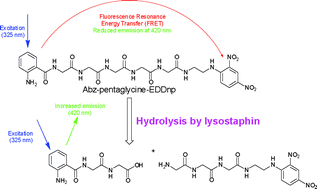Internally quenched peptides for the study of lysostaphin: an antimicrobial protease that kills Staphylococcus aureus
Abstract
Lysostaphin (EC. 3.4.24.75) is a

* Corresponding authors
a
School of Chemistry, Centre for Biomolecular Sciences, University of Nottingham, University Park, Nottingham, UK
E-mail:
neil.thomas@nottingham.ac.uk
Fax: 44 (0115) 951 3564
Tel: 44 (0115) 951 3565
b School of Molecular Medical Sciences, Centre for Biomolecular Sciences, University of Nottingham, University Park, Nottingham, UK
c School of Pharmacy, Centre for Biomolecular Sciences, University of Nottingham, University Park, Nottingham, UK
Lysostaphin (EC. 3.4.24.75) is a

 Please wait while we load your content...
Something went wrong. Try again?
Please wait while we load your content...
Something went wrong. Try again?
R. Warfield, P. Bardelang, H. Saunders, W. C. Chan, C. Penfold, R. James and N. R. Thomas, Org. Biomol. Chem., 2006, 4, 3626 DOI: 10.1039/B607999G
To request permission to reproduce material from this article, please go to the Copyright Clearance Center request page.
If you are an author contributing to an RSC publication, you do not need to request permission provided correct acknowledgement is given.
If you are the author of this article, you do not need to request permission to reproduce figures and diagrams provided correct acknowledgement is given. If you want to reproduce the whole article in a third-party publication (excluding your thesis/dissertation for which permission is not required) please go to the Copyright Clearance Center request page.
Read more about how to correctly acknowledge RSC content.
 Fetching data from CrossRef.
Fetching data from CrossRef.
This may take some time to load.
Loading related content
